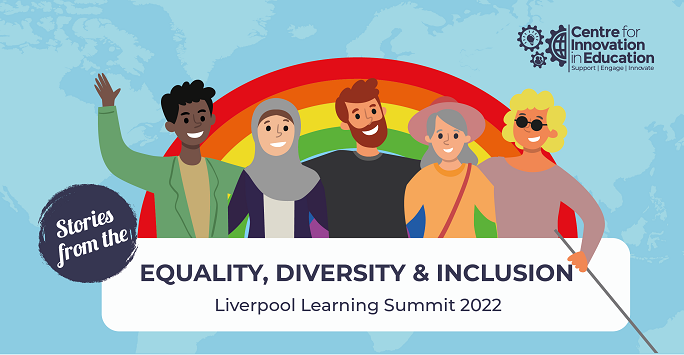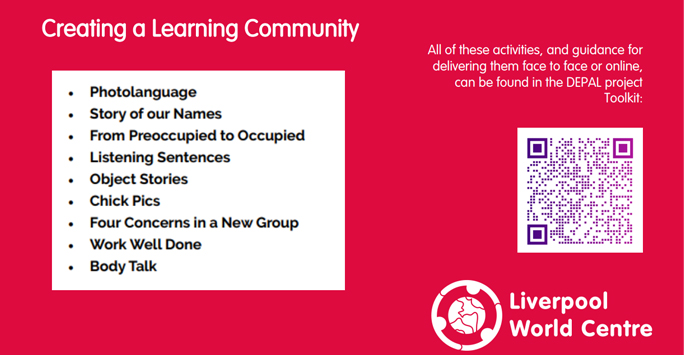Digital Storytelling - Inclusive Education in Practice
Posted on: 4 February 2022 by David Watson in Conference & Event Reports

Kicking off an exciting Liverpool Learning Summit 2022, we had an inspiring talk from Liverpool World Centre’s Karen Wynne, who spoke about participatory education and bringing digital storytelling to life.
With participants in the session from as far as Greece and India, a poll to start us off discovered that 69% of participants had no experience of digital storytelling, and they were now discovering that a digital story is a short personal multimedia tale consisting of around 250 words, a dozen or so pictures, and comes in the form of a short video of around 2 minutes in length.
What is usually an in-depth process, language, art, technology, teamwork, and communication are all key factors to the digital storytelling process – skills that are also crucial to such a wide range of educational subjects and disciplines. Digital storytelling is also a circular method, which uses the experience of the group to achieve the key elements of a digital story: a script, a storyboard, narration, video editing, and a screening event. However most importantly, a story is needed.
Although digital storytelling is very often broken down into 10 steps, in this session we covered 3 distinct parts: creating a learning community, working with stories, and making it digital.
“Digital Stories - when done properly - can be tight as sonnets: multimedia sonnets from the people…and, when imagined as a tool of democratised media, it has - I believe - the potential to change the way we engage in our communities.” - Daniel Meadows [Photobus]
Creating a learning community
“A good start is half the work” is the quote which we are introduced to on-screen, and on expansion we learn that if groups tend to do well in the early stages the group can grow, while neglect in the early stages can result in the group becoming stuck. Practitioners experienced in digital storytelling advise that you have to sow the seeds early for the group to reach its full potential.
We were then posed the question, what is a successful learning community? Amongst the replies it was quite unanimous that communities are places where members feel safe, secure, and there is solidarity within the group. It is also a place where people share experience and knowledge, not something tangible, but a sense of being together in something and being able to learn from each other – a successful learning community is something where everyone gets something back.
We then moved onto a fascinating and thought-provoking activity in which we were invited to view a short slideshow consisting of only images, amongst which there were images of children playing cricket, Spiderman, a tiger, fruit, a family enjoying a barbeque on a beach, a protest, a wheat field, a Banksy piece, musical instruments, hands intertwined, a forest scene, a duck, some chalk, and a jellyfish.
You would be forgiven for thinking, what has all of this got to do with digital storytelling? Well, this is where it all brilliantly comes together. We were then asked to recall a particular image from the slideshow that we saw, but we had to keep this image to ourselves before we were split into breakout rooms of 3 in which we shared what picture we chose and why we chose it. After this step, we were then asked to pick a word that comes to mind when we think of the image that we chose, and again keep this to ourselves. What happens next, you may be thinking…? Well, we revisit this activity a little later.
Working with Stories
“We all have untold stories within.” Stories play a crucial role in sharing knowledge and creating bonds. The Story Circle is a person-centred approach to drawing stories out of participants and is a significant part of digital storytelling. Although flexible to the needs of participants, the activity should support participants and facilitators to:
- Give participants time
- Enable everyone to take an active part
- Allow everyone to see each other (consider room layout)
- Provide a safe, confidential, and non-judgmental space - what is said in the room stays in the room
By the end of this cycle, participants should have a draft version of their chosen story. In short, stages can be considered as: set-up space, play, choose, script, make it digital.
Now, we moved onto the jewel of the workshop – the random words game. Remember the word we had to think of to describe the picture which we chose? This is where that comes into play. We all had to share our word in the chat room, and the presenter then chose 10 random words from the chat and added them onto a whiteboard on-screen. The words chosen were: itchy, complex, rainbow, desolation, sky, action, tranquil, hope, power, fun. Now it was over to us – 5 minutes to write a short story using all of the 10 chosen words, but we shouldn’t exert ourselves too much.
In my defence, I had visited the zoo this weekend, and there was a picture of a tiger in the slideshow that we viewed at the start of this activity, but if you promise not to laugh, here is my story:
The tiger had a complex because he was always itchy, and he was sad, lying in what was once a thriving jungle but now surrounded by desolation. He looked up at the sky and decided he needed to take action, to have hope, and to have fun. So, he blocked out the itching and thought of the tranquil jungle he once knew and the rainbow over the waterfall he once played in, and the tiger smiled.
It is important to note, that you should make time so that everybody gets to share their story – people get excited about creative writing and about sharing their story, after-all, how often do the majority of us take out some time to write creatively? That is exactly what we did – back to our breakout groups to share our story, and it was fascinating to see how people can make such different stories with such varying perspectives using the same 10 words.
Typically, at the end of a story circle you would spend time with people refining, editing, and asking questions to draw out the most interesting aspects of the story, before closing the process, but unfortunately that would not be achievable in such a short but enthralling session today.
Making it digital
Making the story digital is an opportunity for the development of key digital skills, but the overall process is developmental in its structure. This process centres around the storyboard, which can be constructed through the following steps:
- Break the narrative into small chunks of text consisting of 1-2 sentences
- For each sentence, find an image that matches (consider and be conscious of copyright)
- Put these elements together to make the storyboard – something as simple as a 2-column table in Microsoft Word is sufficient
- Audio recording equipment – although higher-end equipment is more mainstream in HE education now, using a mobile device such as an audio recorder is sufficient, providing the audio is clear
- Use clear, well-paced narration
- Video editing – most computer systems have default editing software; however, some technical knowledge is needed to develop instructional guidance
- For those participants with low digital confidence, this process can be achieved in Microsoft PowerPoint
- Sharing digital stories should be a celebratory event
The process outlined above is supported by a European Project, Digital Education Participatory Adult Learning (DEPAL) which is leaving as its legacy a Toolkit as a free online resource that can be downloaded and used in educational settings – a valuable tool for those wishing to explore digital storytelling.

My own main takeaway from this enjoyable workshop, was the threaded activity which we completed in stages throughout the session. From viewing a short slideshow of images, I did not anticipate what the next stages could be, nor that I would end up writing a short story about a tiger. Still, it has stimulated many ideas of how we could apply this to enhance the student learning experience, or promote a sense of belonging in student induction, and if from only 10 words and 60 minutes we can achieve what we did today, I can only imagine that with a little bit more time our students can create whole new worlds to tell us about through their collaboration and work.
Keywords: Liverpool Learning Summit, Summit, Liverpool, Storytelling, Digital.